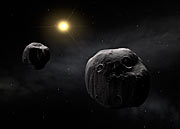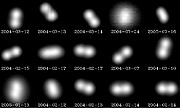Pressemitteilung
The Impossible Siblings
29. März 2007
Combining precise observations obtained by ESO's Very Large Telescope with those gathered by a network of smaller telescopes, astronomers have described in unprecedented detail the double asteroid Antiope, which is shown to be a pair of rubble-pile chunks of material, of about the same size, whirling around one another in a perpetual pas de deux. The two components are egg-shaped despite their very small sizes.
The asteroid (90) Antiope was discovered in 1866 by Robert Luther from Dusseldorf, Germany. The 90th asteroid ever discovered, its name comes from Greek mythology. In 2000, William Merline and his collaborators found that the asteroid was composed of two similarly-sized components, making it a truly 'double' asteroid, one of the very first of this kind in the main belt of asteroids that lies between the orbits of Mars and Jupiter.
"The way double asteroids have formed in the main belt is still unclear," says Pascal Descamps, from the Paris Observatory and lead-author of the paper presenting the new results. "The Antiope system provides us with a unique opportunity to know more about this class of objects and we decided to study it in detail," he adds.
Descamps, with colleague Franck Marchis from the University of California at Berkeley, USA, therefore initiated a large campaign of observations for more than two and a half years starting in January 2003. They used the NACO instrument on ESO's Very Large Telescope at Cerro Paranal for the larger part, while using one of the Keck telescopes for some additional observations in 2005.
NACO allows the astronomers to perform adaptive optics observations, providing images that are mostly free from the blurring effect of the atmosphere. With these, it was always possible to separate clearly the two components of the Antiope system, thereby obtaining a large set of very precise measurements of their positions.
"With this unique set of data, we could determine with utmost precision the course of the two pieces of cosmic rock as they turn around each other," says Marchis. "We found that the two objects are separated by 171 km, and that they perform their celestial dance in 16.5 hours. In fact, we now know this orbital period with a precision of better than half a second."
With the orbit determined, the astronomers could derive the total mass of the system: 828 millions million tons, and found the two objects were rotating around their own axes at the same speed as they orbit each other. Thus, in the same way than the Moon does to the Earth, they always present to each other the same side (something astronomers call 'tidal locking'). Moreover, the two asteroids rotate in the same plane as they orbit each other.
The adaptive optics observations could, however, never resolve the shape of the individual components as they are too small. "But with the new orbit, we could precisely predict that from the end of May to the end of November 2005 the system would present eclipses and occultations," says Marchis. "Such 'mutual events' are unique opportunities to learn a great deal about this double asteroid."
The astronomers invited observers around the world to turn their eyes on the asteroid pair to measure the drops in brightness resulting from the predicted events. Over the six-month period, amateurs and professionals from as far afield as Brazil, Chile, France, Réunion Island, South Africa, and the USA, observed repeated occultations as well as shadows passing over one of the pair.
With this new data, Descamps, Marchis and their team, found enough evidence that the two mountain-like chunks of material forming the Antiope system have the shape of ellipsoids, that is, slightly deformed spheres, almost similar in size: 93.0 x 87.0 x 83.6 km and 89.4 x 82.8 x 79.6 km, respectively. Each asteroid in the pair is thus roughly the size of a large city.
Perhaps the most astonishing result is the fact that the two components have a shape close to the one predicted by the French scientist Edouard Roche in 1849 for self-gravitating, rotating fluid objects orbiting each other and tidally locked.
Of course, the asteroids are not gaseous nor liquids, they are solids, but their internal structure must be so loose that their bodies can readjust themselves due to the gravitational influence of the companion.
The scientists were also able to derive the density of the objects, only a quarter higher than the density of water. This means the asteroids are very porous, having 30 percent empty space, and thereby suggesting a rubble-pile structure. This structure could explain why it was easier for the asteroids to reach equilibrium shapes, while being so small.
"Despite this intensive study, the origin of this unique doublet still remains a mystery," says Descamps. "The formation of such a large double system is an improbable event and represents a formidable challenge to theory. One possibility is that a parent body was spun up so much that it took the shape of an apple core, then split into two similar-sized pieces."
Weitere Informationen
This work is reported in a paper published in the journal Icarus ("Figure of the double Asteroid 90 Antiope from adaptive optics and lightcurve observations", by P. Descamps et al.).
The team is composed of P. Descamps, F. Marchis, F. Vachier, F. Colas, J. Berthier, D. Hestroffer, R. Viera-Martins, and M. Birlan (Observatoire de Paris, France), T. Michalowski and M. Polinska (Adam Mickiewicz University, Poznan, Poland), M. Assafin (Observatorio do Valongo/UFRJ, Brazil), P.B. Dunckel (Rattlesnake Creek Observatory, USA), W. Pych (Nicolaus Copernicus Astronomical Center, Warsaw, Poland), J.-P. Teng-Chuen-Yu, A. Peyrot, B. Payet, J. Dorseuil, Y. Léonie, and T. Dijoux (Makes Observatory, Réunion Island, France). F. Marchis is also at the University of California at Berkeley, USA.
Kontaktinformationen
Franck Marchis
University of California
Berkeley, USA
Tel: +1 (510) 642 3958
E-Mail: fmarchis@berkeley.edu
Pascal Descamps
IMCCE, Observatoire de Paris
Paris, France
Tel: +1 (510) 599 0604
E-Mail: descamps@imcce.fr
Daniel Hestroffer
IMCCE, Observatoire de Paris
Paris, France
Tel: +33 1 4051 2268
E-Mail: hestroffer@imcce.fr
Jerome Berthier
IMCCE, Observatoire de Paris
Paris, France
Tel: +33 1 4051 2260
E-Mail: berthier@imcce.fr
Über die Pressemitteilung
| Pressemitteilung Nr.: | eso0718 |
| Legacy ID: | PR 18/07 |
| Name: | 90 Antiope |
| Typ: | Solar System : Interplanetary Body : Asteroid |
| Facility: | Very Large Telescope |
| Instruments: | NACO |
| Science data: | 2007Icar..187..482D |
Our use of Cookies
We use cookies that are essential for accessing our websites and using our services. We also use cookies to analyse, measure and improve our websites’ performance, to enable content sharing via social media and to display media content hosted on third-party platforms.
ESO Cookies Policy
The European Organisation for Astronomical Research in the Southern Hemisphere (ESO) is the pre-eminent intergovernmental science and technology organisation in astronomy. It carries out an ambitious programme focused on the design, construction and operation of powerful ground-based observing facilities for astronomy.
This Cookies Policy is intended to provide clarity by outlining the cookies used on the ESO public websites, their functions, the options you have for controlling them, and the ways you can contact us for additional details.
What are cookies?
Cookies are small pieces of data stored on your device by websites you visit. They serve various purposes, such as remembering login credentials and preferences and enhance your browsing experience.
Categories of cookies we use
Essential cookies (always active): These cookies are strictly necessary for the proper functioning of our website. Without these cookies, the website cannot operate correctly, and certain services, such as logging in or accessing secure areas, may not be available; because they are essential for the website’s operation, they cannot be disabled.
Functional Cookies: These cookies enhance your browsing experience by enabling additional features and personalization, such as remembering your preferences and settings. While not strictly necessary for the website to function, they improve usability and convenience; these cookies are only placed if you provide your consent.
Analytics cookies: These cookies collect information about how visitors interact with our website, such as which pages are visited most often and how users navigate the site. This data helps us improve website performance, optimize content, and enhance the user experience; these cookies are only placed if you provide your consent. We use the following analytics cookies.
Matomo Cookies:
This website uses Matomo (formerly Piwik), an open source software which enables the statistical analysis of website visits. Matomo uses cookies (text files) which are saved on your computer and which allow us to analyze how you use our website. The website user information generated by the cookies will only be saved on the servers of our IT Department. We use this information to analyze www.eso.org visits and to prepare reports on website activities. These data will not be disclosed to third parties.
On behalf of ESO, Matomo will use this information for the purpose of evaluating your use of the website, compiling reports on website activity and providing other services relating to website activity and internet usage.
Matomo cookies settings:
Additional Third-party cookies on ESO websites: some of our pages display content from external providers, e.g. YouTube.
Such third-party services are outside of ESO control and may, at any time, change their terms of service, use of cookies, etc.
YouTube: Some videos on the ESO website are embedded from ESO’s official YouTube channel. We have enabled YouTube’s privacy-enhanced mode, meaning that no cookies are set unless the user actively clicks on the video to play it. Additionally, in this mode, YouTube does not store any personally identifiable cookie data for embedded video playbacks. For more details, please refer to YouTube’s embedding videos information page.
Cookies can also be classified based on the following elements.
Regarding the domain, there are:
- First-party cookies, set by the website you are currently visiting. They are stored by the same domain that you are browsing and are used to enhance your experience on that site;
- Third-party cookies, set by a domain other than the one you are currently visiting.
As for their duration, cookies can be:
- Browser-session cookies, which are deleted when the user closes the browser;
- Stored cookies, which stay on the user's device for a predetermined period of time.
How to manage cookies
Cookie settings: You can modify your cookie choices for the ESO webpages at any time by clicking on the link Cookie settings at the bottom of any page.
In your browser: If you wish to delete cookies or instruct your browser to delete or block cookies by default, please visit the help pages of your browser:
Please be aware that if you delete or decline cookies, certain functionalities of our website may be not be available and your browsing experience may be affected.
You can set most browsers to prevent any cookies being placed on your device, but you may then have to manually adjust some preferences every time you visit a site/page. And some services and functionalities may not work properly at all (e.g. profile logging-in, shop check out).
Updates to the ESO Cookies Policy
The ESO Cookies Policy may be subject to future updates, which will be made available on this page.
Additional information
For any queries related to cookies, please contact: pdprATesoDOTorg.
As ESO public webpages are managed by our Department of Communication, your questions will be dealt with the support of the said Department.


